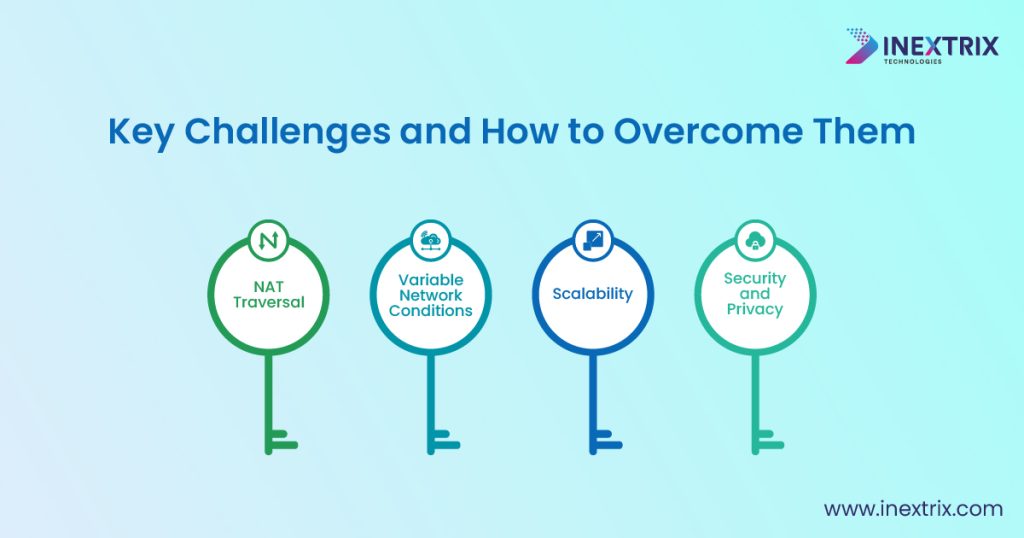Companies often encounter hurdles when developing real time video and audio streaming applications. Certainly, the complexity of WebRTC app development can be a significant barrier, especially for teams lacking specialized engineering expertise. Moreover, mistakes in implementation can lead to poor architecture, negating the advantages WebRTC solution development offers. Missteps during development can result in performance issues, latency problems, and security vulnerabilities, which are critical for maintaining a high-quality user experience.
Creating Skype-like apps for web and mobile (iOS/ Android) has become more accessible with WebRTC. Certainly, this open source technology facilitates the development of voice and video chat applications that require real time audio or video streaming. Importantly, building a WebRTC video and voice chat application allows for peer-to-peer connectivity. Moreover, it enhances the user experience. Interestingly, this direct connection reduces latency. Moreover, it improves the overall call quality. As a result, it makes conversations more natural and fluid.
In this blog post, we are going to cover more details about the WebRTC app development and other details related to building future-proof in-browser communication for voice and video chat applications.
Let’s look at all these points to discuss how you can leverage the real power of WebRTC app development for the development of custom real time communications apps.
1) Defining WebRTC
Simply put, it is a technology that empowers companies to build real time communication apps that leverage the power of browser technology.
Adding real time communication capabilities to web apps has been gaining traction for a while. Under these circumstances, WebRTС appeared on the horizon as a silver-bullet solution for connecting and communicating between modern browsers. Unquestionably, the primary objective was to facilitate real time audio and video communication among users who initiate conversations through web browsers.
WebRTC seamlessly integrates with web browsers through its use of JavaScript APIs and HTML5. Moreover, as an open source project, it offers a straightforward way to incorporate it into your product or service. Additionally, WebRTC exhibits its adaptability, ensuring smooth functionality across a wide range of operating systems.
Certainly, WebRTC revolutionizes communication over the web. Initially developed to support real time video, audio, and data transfers directly within web browsers. Moreover, WebRTC solution development facilitates peer-to-peer communication without needing external plugins or complex software installations. This technology is supported by major browsers and plays a crucial role in modern web applications requiring live interactive capabilities.
Technical Background
At its core, WebRTC uses a collection of standard protocols and JavaScript APIs. The essence of WebRTC’s functionality lies in its use of the RTCPeerConnection API to manage streaming data between peers. Additionally, it employs the RTCDataChannel API for transmitting arbitrary data channels, and the MediaStream API for capturing and transmitting audio and video streams.
These APIs work in conjunction to allow developers to build robust real time communication applications directly in the browser. Moreover, it does not need special server arrangements for streaming audio and video content. The technologies behind WebRTC are implemented as an open web standard, making them widely accessible and continually improved upon by a community of developers, including major stakeholders like Apple, Google, Microsoft, and Mozilla.
Unquestionably, WebRTC supports a wide range of codecs and is compatible with various browsers and platforms, ensuring that your application can reach a broad audience without compatibility issues. For instance, WebRTC’s use of VP8 and VP9 video codecs and Opus audio codecs ensures high-quality streaming. It also includes built-in mechanisms for NAT traversal and encryption, which are essential for maintaining privacy and security in communication apps.
In addition, WebRTC’s API is designed to be easy to integrate, even for developers who are not experts in networking. Interestingly, it provides a rich set of features that allow developers to focus on building innovative applications rather than worrying about the underlying communication technology.
2) Importance of Building a WebRTC Video and Voice Chat Application

Significantly, this development boosts real time communication capabilities. Users demand instant and reliable connectivity for various applications, from customer support to social interactions. Moreover, WebRTC app development provides the technology needed to meet these demands. As a result, these communication apps ensure high-quality video and audio streams that make conversations feel natural and fluid.
Economical and Effective
WebRTC solution development leverages open source technologies. As a result, it reduces the cost and complexity of development. This is crucial for businesses looking to implement robust communication features without a significant investment in proprietary software or infrastructure. The peer-to-peer nature of WebRTC also minimizes the need for expensive server resources, further reducing costs. You can also take advantage of tools like fraud detection and management.
Extensive Compatibility
One of the key advantages of WebRTC app development is its compatibility across different platforms and devices. WebRTC works seamlessly on desktops, smartphones, and tablets, ensuring that users have a consistent experience regardless of their device. This broad compatibility is essential for applications that aim to reach a diverse user base.
Enhanced User Engagement
Undoubtedly, building a WebRTC video and voice chat application can significantly enhance user engagement. Real-time communication keeps users connected and engaged. As a result, it enhances the overall user experience. Particularly, this is important for applications in education, healthcare, and customer service, where timely and effective communication is critical.
Adaptable and Scalable
WebRTC solution development offers adaptability and scalability, allowing businesses to easily respond to growing user demands. The technology supports a wide range of use cases, from simple one-on-one calls to complex multi-party conferences. Surely, this scalability ensures that the application can grow alongside the business, accommodating increasing numbers of users and more sophisticated communication needs.
Security and Privacy
WebRTC includes built-in security features such as encryption and secure data transfer protocols. Unquestionably, this is crucial for protecting user data and maintaining privacy in communications. Implementing these security measures is essential for gaining user trust and ensuring compliance with regulatory requirements.
3) Role of WebRTC in Developing WebRTC Video and Voice Chat App

WebRTC app development is available to build any custom app that supports multiple communication channels and real time interactions among multiple parties. Let’s just understand the role of this technology in building a WebRTC video and voice chat application.
Enabling Peer-to-Peer Connectivity
WebRTC (Web Real-Time Communication) plays a crucial role in developing video and voice chat applications by enabling direct peer-to-peer connectivity. This direct connection reduces latency and improves call quality, providing users with a seamless communication experience. Building a WebRTC video and voice chat application takes full advantage of this technology to ensure real-time interactions without the need for intermediary servers.
Utilizing JavaScript APIs and HTML5
WebRTC integrates seamlessly with web browsers through JavaScript APIs and HTML5. This integration allows developers to easily implement real-time communication features directly into their web applications. WebRTC app development leverages these APIs to capture, encode, and transmit audio and video streams, simplifying the development process and reducing the need for additional plugins or software.
Supporting Multi-Platform Compatibility
One of the strengths of WebRTC solution development is its compatibility across various platforms and devices. Whether users are on desktops, smartphones, or tablets, WebRTC ensures that the communication experience is consistent and reliable. This extensive compatibility makes WebRTC an ideal choice for developers aiming to reach a broad audience with their video and voice chat applications.
Improving Scalability and Flexibility
WebRTC’s architecture supports scalability and flexibility, allowing applications to handle a growing number of users and more complex communication needs. This is essential for businesses that expect their user base to expand. WebRTC app development can easily adapt to these changes, ensuring that the application remains robust and responsive even as demand increases.
Enhancing Security and Privacy
Security is a critical aspect of any communication app. WebRTC includes built-in encryption and secure data transfer protocols to protect user data and maintain privacy. By incorporating these security features, building a WebRTC video and voice chat application ensures that user interactions are safe from eavesdropping and unauthorized access, thereby gaining user trust and meeting regulatory requirements.
Leveraging Open Source Technology
As an open-source project, WebRTC benefits from continuous improvements and contributions from a global community of developers. This ensures that the technology stays up to date with the latest advancements and remains a reliable foundation for developing communication apps. WebRTC solution development leverages this open-source nature to create innovative and cost-effective communication solutions.
Recommended Reading: WebRTC Gateway: Build Sustainable Browser Communication Platform. This blog post covers an insight into developing a sustainable platform using web real time communication technology at its best.
4) Major Challenges and How to Overcome Those

WebRTC app development faces several key challenges. NAT traversal is a significant hurdle, often blocking direct peer-to-peer communication. WebRTC overcomes this with STUN and TURN servers, ensuring reliable connectivity even behind firewalls. Variable network conditions also pose a challenge, affecting audio and video quality. Adaptive bitrate streaming addresses this by dynamically adjusting the quality based on network performance.
Scalability is crucial as user bases grow; solutions include load balancing and media server clusters to manage increased traffic. Security and privacy are paramount, with end-to-end encryption and regular security audits being essential to protect user data. These strategies ensure robust, scalable, and secure WebRTC solution development.
NAT Traversal
One of the significant challenges in WebRTC app development is NAT traversal. Network Address Translation (NAT) can block direct peer-to-peer communication between clients, making it difficult to establish a connection. To address this issue, WebRTC uses STUN (Session Traversal Utilities for NAT) and TURN (Traversal Using Relays around NAT) servers.
Solution
While STUN servers help discover the public IP address, TURN servers relay traffic when direct peer-to-peer communication is blocked by NAT or firewalls. Deploying TURN servers ensures connectivity across all network types, though it may increase bandwidth costs. This dual approach of using STUN and TURN servers helps maintain a robust and reliable connection.
Variable Network Conditions
Handling different network speeds and conditions is another challenge, especially in multi-party scenarios where participants have varying bandwidth capacities. This can lead to inconsistent video and audio quality, affecting the user experience.
Solution
Implementing adaptive bitrate streaming can dynamically adjust the video quality according to the user’s current network conditions. This ensures smoother communication by optimizing the media streams in real time. Continuous monitoring and analytics can also help identify and address network issues promptly. Tools like WebRTC Internals in Chrome provide detailed insights into WebRTC connections, enabling developers to troubleshoot and optimize performance effectively.
Scalability
As the user base grows, scaling a WebRTC application to handle increased traffic and more complex communication needs can be challenging. Ensuring that the application remains responsive and performs well under heavy load requires careful planning and optimization.
Solution
To address scalability, developers can use techniques such as load balancing and media server clusters. These methods distribute the load across multiple servers, ensuring that no single server becomes a bottleneck. Additionally, implementing a robust architecture that supports horizontal scaling can help manage increased user demand effectively. By planning for scalability from the outset, developers can build applications that grow alongside their user base.
Security and Privacy
Maintaining security and privacy is crucial in any communication application. WebRTC includes built-in encryption, but developers must ensure these features are properly implemented to protect user data.
Solution
Using secure data transfer protocols and implementing end-to-end encryption can safeguard communications. Regular security audits and updates are essential to address vulnerabilities and ensure compliance with regulatory requirements. By prioritizing security, WebRTC solution development can protect user privacy and build trust.
Concluding Note
In summary, WebRTC offers a versatile, powerful, and efficient means of enabling real-time communication within web applications. Its integration through JavaScript and HTML5, combined with its open-source nature, makes it an ideal solution for developing high-quality video and voice chat applications that work seamlessly across various devices and platforms. This article delves into the essentials of WebRTC app development, guiding you through the process of creating a robust video and voice chat solution, from setting up the development environment to implementing key features and optimizing performance.
In conclusion, businesses often encounter hurdles when developing real-time video and audio streaming applications. The complexity of WebRTC application development can be a significant barrier, especially for teams lacking specialized engineering expertise. Moreover, mistakes in implementation can lead to poor architecture, negating the advantages WebRTC solution development offers. Missteps during development can result in performance issues, latency problems, and security vulnerabilities, which are critical for maintaining a high-quality user experience.
If you are interested in building a WebRTC video and voice chat application, we can help you with our development services. Contact us now to learn how we can help you with our WebRTC app development services.
